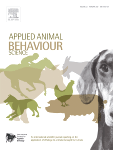Type de document : Article scientifique publié dans Biosystem Engineering
Auteurs : Ali Alameer, Ilias Kyriazakis, Hillary A. Dalton, Amy L.Miller, Jaume Bacardit
Résumé en français (traduction) : Reconnaissance automatique du comportement d’alimentation et de recherche de nourriture chez les porcs grâce à l’apprentissage profond
Des systèmes d’alerte précoce automatisés et basés sur la vidéo ont été développés pour détecter les changements de comportement dans des groupes de porcs afin de surveiller leur état de santé et de bien-être. Dans un contexte commercial, l’enregistrement automatique du comportement alimentaire reste un défi en raison des problèmes de variation de l’éclairage, des obstacles et de la ressemblance entre plusieurs porcs. De plus, ces systèmes, qui reposent sur le suivi des porcs, surestiment souvent le temps réel passé à se nourrir, en raison de l’incapacité à identifier et/ou exclure les visites non nutritives (VNN) de la zone d’alimentation. Pour résoudre ces problèmes, nous avons développé une méthode robuste de détection de la prise alimentaire basée sur l’apprentissage profond qui (a) ne repose pas sur le suivi des porcs et (b) est capable de distinguer la prise alimentaire des visites non nutritives pour un groupe de porcs. Nous avons d’abord validé notre méthode à l’aide de séquences vidéo provenant d’une exploitation porcine commerciale, dans divers contextes. Nous démontrons la capacité de cette méthode automatisée à identifier les comportements d’alimentation et de VNN avec une grande précision (99,4% ± 0,6%). Nous avons ensuite testé la capacité de la méthode à détecter les changements dans les comportements alimentaires et de VNN pendant une période planifiée de restriction alimentaire. Nous avons constaté que la méthode était capable de quantifier automatiquement les changements attendus dans les comportements alimentaires et de VNN. Notre méthode est capable de surveiller de manière robuste et précise le comportement alimentaire de groupes de porcs logés commercialement, sans avoir besoin de capteurs supplémentaires ou de marquage individuel. Elle présente un grand potentiel d’application pour la détection précoce des problèmes de santé et de bien-être des porcs en élevages commerciaux.
Résumé en anglais (original) : Automated, vision-based early warning systems have been developed to detect behavioural changes in groups of pigs to monitor their health and welfare status. In commercial settings, automatic recording of feeding behaviour remains a challenge due to problems of variation in illumination, occlusions and similar appearance of different pigs. Additionally, such systems, which rely on pig tracking, often overestimate the actual time spent feeding, due to the inability to identify and/or exclude non-nutritive visits (NNV) to the feeding area. To tackle these problems, we have developed a robust, deep learning-based feeding detection method that (a) does not rely on pig tracking and (b) is capable of distinguishing between feeding and NNV for a group of pigs. We first validated our method using video footage from a commercial pig farm, under a variety of settings. We demonstrate the ability of this automated method to identify feeding and NNV behaviour with high accuracy (99.4% ± 0.6%). We then tested the method’s ability to detect changes in feeding and NNV behaviours during a planned period of food restriction. We found that the method was able to automatically quantify the expected changes in both feeding and NNV behaviours. Our method is capable of monitoring robustly and accurately the feeding behaviour of groups of commercially housed pigs, without the need for additional sensors or individual marking. This has great potential for application in the early detection of health and welfare challenges of commercial pigs.
Publication ayant donné lieu à un article dans Pig333 le 25 mars 2021 : Automatic recognition of feeding and foraging behaviour in pigs



